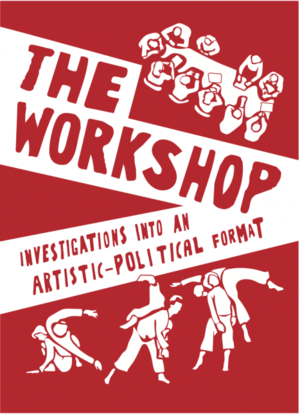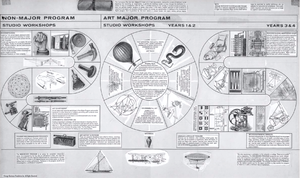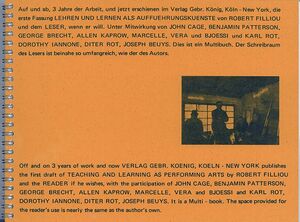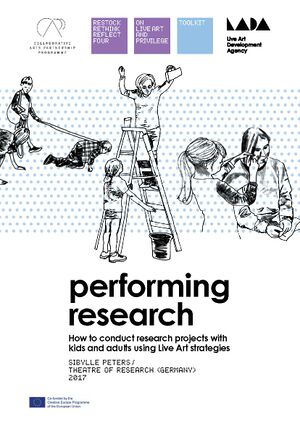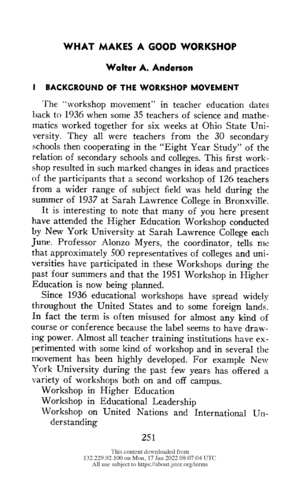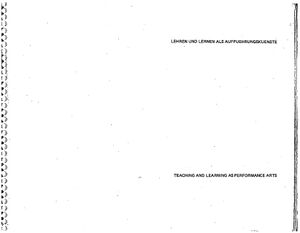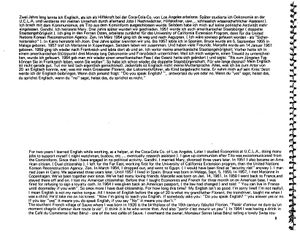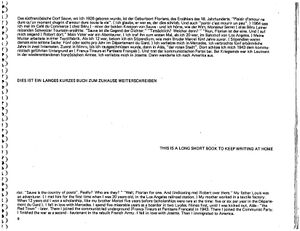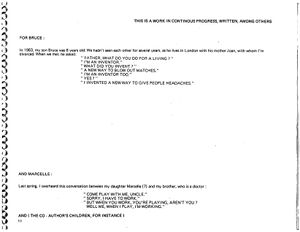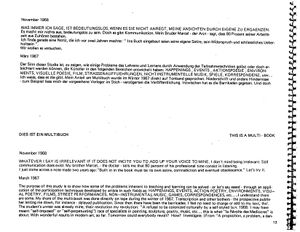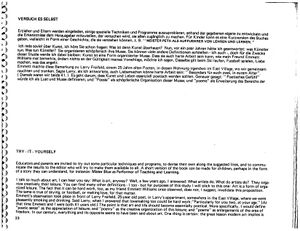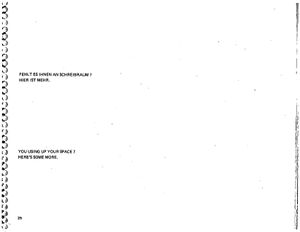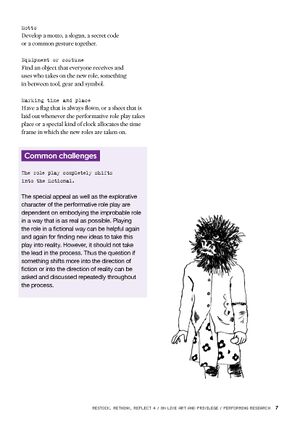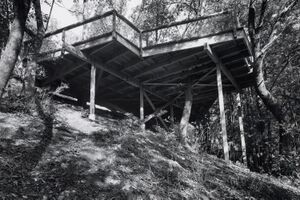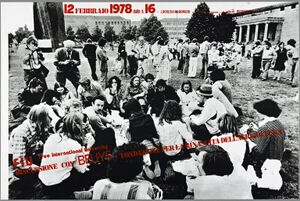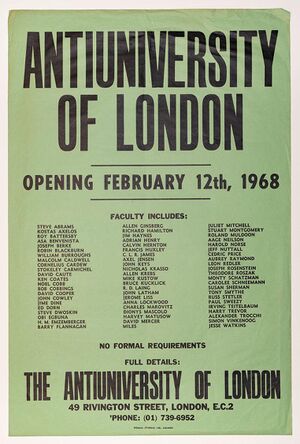|
|
| (48 intermediate revisions by 2 users not shown) |
| Line 1: |
Line 1: |
| <div class="article Workshop-Histories-and-Practices layout-2" id="Workshop_Histories_and_Practices"> | | <div class="article Workshop-Histories-and-Practices layout-2" id="Workshop_Histories_and_Practices"> |
|
| |
|
| | <div class="hide-from-book scriptothek"> |
| | |
| | [[File:Journal-workshops.png|thumb|Walter A. Anderson, “What Makes a Good Workshop,” ''The Journal of Educational Sociology'' Vol. 24, No. 5 (January, 1951), pp. 251-261. https://wiki2print.hackersanddesigners.nl/wiki/mediawiki/images/7/74/2263639.pdf]] |
| | |
| | [[File:Studio-workshops.png|thumb|“Curriculum Plan,” Proposals for Art Education from a Year Long Study by Fluxus artist George Maciunas, 1968-1969. The image was shown in Heike Rom's presentation. http://georgemaciunas.com/exhibitions/george-maciunas-point-dappui/curriculum-plan/]] |
| | |
| | [[File:Slide-Hanna-Podig-2.png|thumb|In her talk "The Workshop as an Emancipatory Mediation Method of Resistant Practices" political activist Hanna Poddig referred to the [[#On_consensus,_in_two_parts|discussion scores]] that are also common in Consensus Decision-making practices]] |
| | |
| | [[File:JohnCageWaterWalk.png|thumb|"A section of Water Walk," score by John Cage]] |
| | |
| | [[File:CivicYouth Strategy.jpg|thumb|Notes by Suzanne Lacy on the ongoing civic engagement in Oakland and the Oakland Youth Policy Initiative. Image courtesy of Suzanne Lacy.]] |
| | |
| | [[File:RobertFilliou.jpg|thumb|Page from "Teaching and Learning as Performings Arts" in 1979. Find a downloadable pdf of the publication on: https://monoskop.org/images/9/93/Robert_Filliou_Teaching_and_Learning_as_Performing_Arts.pdf]] |
| | |
| | [[File:Pages from Robert_Filliou_Teaching_and_Learning_as_Performing_Arts-2.jpg|thumb|Fluxus artist Robert Filliou published the book "Teaching and Learning as Performings Arts" in 1979. The book is designed in a workbook manner, leaving space for annotation in the middle of the page https://monoskop.org/images/9/93/Robert_Filliou_Teaching_and_Learning_as_Performing_Arts.pdf]] |
| | [[File:Pages from Robert_Filliou_Teaching_and_Learning_as_Performing_Arts-3.jpg|thumb]] |
| | [[File:Pages from Robert_Filliou_Teaching_and_Learning_as_Performing_Arts-4.jpg|thumb]] |
| | [[File:Pages from Robert_Filliou_Teaching_and_Learning_as_Performing_Arts-5.jpg|thumb]] |
| | [[File:Pages from Robert_Filliou_Teaching_and_Learning_as_Performing_Arts-6.jpg|thumb]] |
| | [[File:Pages from Robert_Filliou_Teaching_and_Learning_as_Performing_Arts-7.jpg|thumb]] |
| | [[File:Pages from Robert_Filliou_Teaching_and_Learning_as_Performing_Arts-8.jpg|thumb]] |
| | |
| | [[File:Pages-from-SYBILLE_TOOLKIT_WEB.jpg|thumb|Page from: Sibylle Peters, performing research: How to conduct research projects with kids and adults using Live Art strategies, (London: Live Art Development Agency, 2017), https://www.thisisliveart.co.uk/wp-content/uploads/uploads/documents/SYBILLE_TOOLKIT_WEB.pdf.]] |
| | |
| | [[File:Pages-from-SYBILLE_TOOLKIT_WEB-2.jpg|thumb|Page from: Sibylle Peters, performing research: How to conduct research projects with kids and adults using Live Art strategies, (London: Live Art Development Agency, 2017), https://www.thisisliveart.co.uk/wp-content/uploads/uploads/documents/SYBILLE_TOOLKIT_WEB.pdf.</ref>]] |
| | </div> |
| === Workshop Histories and Practices === | | === Workshop Histories and Practices === |
| <span class="author">A Conversation Between Heike Roms and Anja Groten</span> | | <span class="author">In conversation with Heike Roms</span> |
| '''Anja Groten:''' In May 2021 I participated in an online conference titled “The Workshop as Artistic-Political Format,” organized by Institute for Cultural Inquiry in Berlin.<ref> “The Workshop: Investigations Into an Artistic-Political Format,” ICI Berlin, March 26-28, 2021, https://www.ici-berlin.org/events/the-workshop/.</ref> The conference drew together practitioners from various fields of interests, including choreographers, dancers, theater makers, artists, scholars, musicians, and activists who reflected on “workshop” as a format, site, and phenomenon from their own perspectives. Heike, you gave the presentation "The Changing Fate of the Workshop and the Emergence of Live Art,” which particularly resonated with me. | | '''Anja Groten:''' In May 2021 I participated in an online conference titled “The Workshop as Artistic-Political Format,” organized by Institute for Cultural Inquiry in Berlin.<ref> “The Workshop: Investigations Into an Artistic-Political Format,” ICI Berlin, March 26-28, 2021, https://www.ici-berlin.org/events/the-workshop/.</ref> The conference drew together practitioners from various fields of interests, including choreographers, dancers, theater makers, artists, scholars, musicians, and activists who reflected on “workshop” as a format, site, and phenomenon from their own perspectives. Heike, you gave the presentation "The Changing Fate of the Workshop and the Emergence of Live Art,” which particularly resonated with me. |
|
| |
|
| '''Heike Roms:''' I came to the topic of workshops because in my work I look at the emergence of performance art in the sixties and seventies. I became interested in particular in the emergence of performance art within art educational contexts, in a conceptualization of a pedagogy of performance. I've read your chapter on “Workshop Production,”<ref> Anja Groten, “Workshop Production,” Figuring Things Out Together. On the Relationship Between Design and Collective Practice (PhD Diss., Leiden University, 2022).</ref> which I really enjoyed. Some of the research you've done is helpful to me because I too have found that there's actually very little written about the workshop as a practice. That is, people have written about specific workshops so you can find material on workshops given by a particular artist. But there is little reflection on the workshop as a format, as a genre, as a site, as whatever we might call it. That surprised me, given that it's sort of ubiquitous in practice. There are books on performance laboratories, for example, and there is a connected history between the workshop and labs, the studio space, and rehearsals as a format. But there is very little on the workshop, certainly within performance studies or art history discourse, so I became intrigued by this ubiquitous form that remains largely unexamined. It's great that through the work of Kai van Eikels and the 2021 conference he co-organized there's a new kind of attention being paid to it, through your work as well. But there is not enough available about the history of the workshop to help us understand at what point this flip occurred from considering the workshop as an actual physical site to approaching the workshop as an event format. You write about this as well. The two meanings, of course, continued to exist in parallel, particularly in the context of art schools. But at what point did the workshop become an event, a time-based learning experience, as well as a site of making—a ''Werkstatt''? I don't know how and when that occurred. My suspicion is that it was sometime around the fifties and sixties. | | '''Heike Roms:''' I came to the topic of workshops because in my work I look at the emergence of performance art in the sixties and seventies. I became interested in particular in the emergence of performance art within art educational contexts, in a conceptualization of a pedagogy of performance. I've read your chapter on “Workshop Production,”<ref> Anja Groten, “Workshop Production,” Figuring Things Out Together. On the Relationship Between Design and Collective Practice (PhD Diss., Leiden University, 2022).</ref> which I really enjoyed. Some of the research you've done is helpful to me because I too have found that there's actually very little written about the workshop as a practice. That is, people have written about specific workshops so you can find material on workshops given by a particular artist. But there is little reflection on the workshop as a format, as a genre, as a site, as whatever we might call it. That surprised me, given that it's sort of ubiquitous in practice. There are books on performance laboratories, for example, and there is a connected history between the workshop and labs, the studio space, and rehearsals as a format. But there is very little on the workshop, certainly within performance studies or art history discourse, so I became intrigued by this ubiquitous form that remains largely unexamined. It's great that through the work of Kai van Eikels and the 2021 conference he co-organized there's a new kind of attention being paid to it, through your work as well. But there is not enough available about the history of the workshop to help us understand at what point this flip occurred from considering the workshop as an actual physical site to approaching the workshop as an event format. You write about this as well. The two meanings, of course, continued to exist in parallel, particularly in the context of art schools. But at what point did the workshop become an event, a time-based learning experience, as well as a site of making—a ''Werkstatt''? I don't know how and when that occurred. My suspicion is that it was sometime around the fifties and sixties. |
| | |
| | <div class="visual-footnote img"> |
| | [[File:ICI-Homepage.png|thumb|Announcement image to the conference “The Workshop: Investigations Into an Artistic-Political Format.” https://www.ici-berlin.org/events/the-workshop/]] |
| | </div> |
| | |
| | <div class="visual-footnote img"> |
| | [[File:Anna-Halprin_Dance.jpeg|thumb|Image of the Anna Halprin’s Dance Deck, an architectonic arrangement, and workshop site that transformed dance practice, 1951-1954, with Lawrence Halprin. The image was shown by Kai Ekels in the introduction presentation of “The Workshop: Investigations Into an Artistic-Political Format.”]] |
| | </div> |
|
| |
|
| '''AG:''' There is the ''The Journal of Educational Sociology'' that was published in 1951 and refers to the first organized professional education activity under the name of a workshop. It took place at Ohio State University in 1936.<ref> The Journal of Educational Sociology, Vol. 24, No. 5 (Jan1951): 249-250, https://www.jstor.org/stable/2263638.</ref> I remember you were talking about the relation between the occurrence of workshops and the emergence of a certain resistance toward the steady structures of art schools in the fifties and sixties in the UK—a resistance to legitimized knowledge practices and skills. Art students wanted to rid themselves of a certain authority of disciplines or disciplined learning and instead wanted to take things into their own hands. | | '''AG:''' There is the ''The Journal of Educational Sociology'' that was published in 1951 and refers to the first organized professional education activity under the name of a workshop. It took place at Ohio State University in 1936.<ref> The Journal of Educational Sociology, Vol. 24, No. 5 (Jan1951): 249-250, https://www.jstor.org/stable/2263638.</ref> I remember you were talking about the relation between the occurrence of workshops and the emergence of a certain resistance toward the steady structures of art schools in the fifties and sixties in the UK—a resistance to legitimized knowledge practices and skills. Art students wanted to rid themselves of a certain authority of disciplines or disciplined learning and instead wanted to take things into their own hands. |
|
| |
|
| [[File:Journal-workshops.png|thumb]]
| | '''HR:''' In the specific history I looked at, which is that of Cardiff College of Art, I found that there is a confluence between the workshop and two emancipatory movements. First was the move toward the workshop as a learning format through the impetus of the Bauhaus, which in the 1960s developed a huge impact on art schools across the UK. Traditionally people weren’t really talking about workshops as sites of making in the context of art schools; the workshop was the place of the plumber or the blacksmith, while artists worked in ateliers or studios. I think that the idea of the workshop as a place of making was introduced to the art school through the Bauhaus philosophy, which was a vehicle for the emancipation of art education. All of a sudden art was being approached in the same way as other practices of making were being approached. No longer did we have the sculpture atelier or the drawing room. Now there were ceramics workshops, metal workshops, printmaking workshops but also painting workshops and sculpture workshops (or ‘2D’ and ‘3D’ workshops as they were often called at the time). This move introduced a different kind of art making. |
|
| |
|
| '''HR:''' In the specific history I looked at, which is that of Cardiff College of Art, I found that there is a confluence between the workshop and two emancipatory movements. First was the move toward the workshop as a learning format through the impetus of the Bauhaus, which in the 1960s developed a huge impact on art schools across the UK. Traditionally people weren’t really talking about workshops as sites of making in the context of art schools; the workshop was the place of the plumber or the blacksmith, while artists worked in ateliers or studios. I think that the idea of the workshop as a place of making was introduced to the art school through the Bauhaus philosophy, which was a vehicle for the emancipation of art education. All of a sudden art was being approached in the same way as other practices of making were being approached. No longer did we have the sculpture atelier or the drawing room. Now there were ceramics workshops, metal workshops, printmaking workshops but also painting workshops and sculpture workshops (or ‘2D’ and ‘3D’ workshops as they were often called at the time). This move introduced a different kind of art making. This change that occurred in art schools in the UK in the sixties through a new approach to art education known as ‘Basic Design’ was very much driven by the reception of the Bauhaus approach and in particular Joseph Itten’s Vorkurs (preliminary course). Workshop production was seen as a new, more emancipatory form of art making. It came out of the experiences of the Second World War and the desire to give art students a different sort of experience—one that connected them to the contemporary world rather than traditional skills training and that aimed to overcome the distinction between art, craft and design.
| | <div class="visual-footnote img"> |
| | [[File:Studio-workshops.png|thumb|“Curriculum Plan,” Proposals for Art Education from a Year Long Study by Fluxus artist George Maciunas, 1968-1969. The image was shown in Heike Rom's presentation. http://georgemaciunas.com/exhibitions/george-maciunas-point-dappui/curriculum-plan/]] |
| | </div> |
|
| |
|
| | This change that occurred in art schools in the UK in the sixties through a new approach to art education known as ‘Basic Design’ was very much driven by the reception of the Bauhaus approach and in particular Joseph Itten’s ''Vorkurs'' (preliminary course). Workshop production was seen as a new, more emancipatory form of art making. It came out of the experiences of the Second World War and the desire to give art students a different sort of experience—one that connected them to the contemporary world [[#Learning_to_Experiment,_Sharing_Techniques|rather than traditional skills training]] and that aimed to overcome the distinction between art, craft and design. |
| The second shift is where performance comes in in the 1960s. Teachers and students saying: We don't want all of that material making in the workshop. We want to make something that's ephemeral and that's collective and that's participatory. We don't want to be hammering away all day in the workshop. Instead we do this other thing where we get together and we make something that’s not actually about producing any objects, and we'll call that a workshop as well. That's the event-based rather than space-based concept of the workshop. | | The second shift is where performance comes in in the 1960s. Teachers and students saying: We don't want all of that material making in the workshop. We want to make something that's ephemeral and that's collective and that's participatory. We don't want to be hammering away all day in the workshop. Instead we do this other thing where we get together and we make something that’s not actually about producing any objects, and we'll call that a workshop as well. That's the event-based rather than space-based concept of the workshop. |
| | | In dance, people were already talking about workshops as events in the fifties. I don't know when the shift occurred from the workshop as a site toward the more ephemeral understanding of the workshop as event, how that happened, but it's interesting because what motivated the artists in the sixties that I have been looking at—and they explicitly say so in their notes—was that this move toward the ephemeral was about searching for more equitable relationships that do away with the teacher-student division. That division had been further cemented by the remains of the Bauhaus philosophy and its celebration of mastery. I think that was one of the key shifts toward this more [[#Scripting_Workshops|ephemeral meaning of the workshop]]. It was no longer about a master passing on knowledge to their students. It became about collective making. And everybody took collective charge and responsibility for that making. The educators on whom I've done research actually say that they wanted to get away from producing objects toward collective action. But, as you say, the workshop can very easily be co-opted like so much of the sixties was. Was that the last hurrah of collectivism? Or was it actually what lay the groundwork for the entry of neoliberalism into education as we now know it? |
| | | <div class="visual-footnote img"> |
| In dance, people were already talking about workshops as events in the fifties. I don't know when the shift occurred from the workshop as a site toward the more ephemeral understanding of the workshop as event, how that happened, but it's interesting because what motivated the artists in the sixties that I have been looking at—and they explicitly say so in their notes—was that this move toward the ephemeral was about searching for more equitable relationships that do away with the teacher-student division. That division had been further cemented by the remains of the Bauhaus philosophy and its celebration of mastery. I think that was one of the key shifts toward this more ephemeral meaning of the workshop. It was no longer about a master passing on knowledge to their students. It became about collective making. And everybody took collective charge and responsibility for that making. The educators on whom I've done research actually say that they wanted to get away from producing objects toward collective action. But, as you say, the workshop can very easily be co-opted like so much of the sixties was. Was that the last hurrah of collectivism? Or was it actually what lay the groundwork for the entry of neoliberalism into education as we now know it? | | [[File:FreeInternationalUniversity.jpeg|thumb|Announcement for the ''Free International University'']] |
| | | [[File:30593911032.jpeg|thumb|Announcement for the ''Antiuniversity of London'', 1978]] |
| | </div> |
| '''AG:''' I myself am wondering whether organizing workshops can generally be considered an emancipatory practice at all? Perhaps there cannot or should not be a general answer to this question. At the school where I work as an educator, some argue the educational system builds upon rather precarious labor conditions, where everyone works as a self-employed freelancer. Simultaneously, more and more workshops are being organized, which at times can clutter the education. Students are supposed to self-initiate and self-organize as well. They often resort to organizing workshops for each other. In my view, such conditions sometimes also show the limits of what can be accomplished with workshops. I think it's important to have more discussions about the workshop as a format and its implications for the learning economy. How to speak about and practice workshops in a way that still allows us to do the things we want to do, whilst also paying critical attention to the undesirable conditions it is intermingled with. | | '''AG:''' I myself am wondering whether organizing workshops can generally be considered an emancipatory practice at all? Perhaps there cannot or should not be a general answer to this question. At the school where I work as an educator, some argue the educational system builds upon rather precarious labor conditions, where everyone works as a self-employed freelancer. Simultaneously, more and more workshops are being organized, which at times can clutter the education. Students are supposed to self-initiate and self-organize as well. They often resort to organizing workshops for each other. In my view, such conditions sometimes also show the limits of what can be accomplished with workshops. I think it's important to have more discussions about the workshop as a format and its implications for the learning economy. How to speak about and practice workshops in a way that still allows us to do the things we want to do, whilst also paying critical attention to the undesirable conditions it is intermingled with. |
|
| |
| How was it for you? Did the invitation to the conference lead you to take a deeper look at the phenomenon of the workshop? Or were you already busy with it? | | How was it for you? Did the invitation to the conference lead you to take a deeper look at the phenomenon of the workshop? Or were you already busy with it? |
|
| |
|
| '''HR:''' Yes, it would be fair to say it led to a deeper engagement with the notion of the workshop. I had been working on this material before and I've written about it too. But I had never really paid attention to the frequency of the word ‘workshop’ in the material I had researched until the invitation came to speak at the conference. It was then that I realized that the workshop is a really productive format to be talking about. | | '''HR:''' Yes, it would be fair to say it led to a deeper engagement with the notion of the workshop. I had been working on this material before and I've written about it too. But I had never really paid attention to the frequency of the word ‘workshop’ in the material I had researched until the invitation came to speak at the conference. It was then that I realized that the workshop is a really productive format to be talking about. |
| | I wrote a paper on this before in which I talked about the idea that artists and performance educators in the sixties and seventies in the UK were creating events as a kind of [[#Critical_Coding_Cookbook|parallel institution]]. These events aimed to serve the function of an art school without replicating its hierarchical structures. This was the case in Cardiff, but also in other places in the UK such as Leeds College of Art. I was grateful that I was invited to think more about this by the conference. I looked at my examples, and it is specifically “the workshop as event” that emerged as a kind of parallel institution at the time. It wasn't really the performances these teachers and students went on to make together, but the workshop as a learning format that I think they clustered all their ideas around. |
|
| |
|
| I wrote a paper on this before in which I talked about the idea that artists and performance educators in the sixties and seventies in the UK were creating events as a kind of parallel institution. These events aimed to serve the function of an art school without replicating its hierarchical structures. This was the case in Cardiff, but also in other places in the UK such s Leeds College of Art. I was grateful that I was invited to think more about this by the conference. I looked at my examples, and it is specifically “the workshop as event” that emerged as a kind of parallel institution at the time. It wasn't really the performances these teachers and students went on to make together, but the workshop as a learning format that I think they clustered all their ideas around. | | '''AG:''' I stumbled upon the conference last minute and wasn't aware of this whole community of performance artists and live arts who consider the workshop as an artistic medium. It's also interesting that the workshop, because of its ambiguity, manages to converge all these different worlds and unveil commonalities between them. For instance a policeman<ref>Sebastian Voigt (Polizei Berlin), "The Training of the Berlin Police Force in the Workshop"</ref> speaking about their conflict resolution workshops, and the activist who learns about tying themselves to a tree and how to negotiate with the police while doing so <ref>Hanna Poddig, "The Workshop as an Emancipatory Mediation Method of Resistant Practices"</ref>. Both speaking about the same sort of thing at the same conference from an entirely different vantage point. |
|
| |
|
| '''AG:''' I stumbled upon the conference last minute and wasn't aware of this whole community of performance artists and live arts who consider the workshop as an artistic medium. It's also interesting that the workshop, because of its ambiguity, manages to converge all these different worlds and unveil commonalities between them. For instance a policeman speaking about their conflict resolution workshops, and the activist who learns about tying themselves to a tree and how to negotiate with the police while doing so. Both speaking about the same sort of thing at the same conference from an entirely different vantage point.
| | <div class="visual-footnote img"> |
| | [[File:Slide-Hanna-Podig-2.png|thumb|In her talk "The Workshop as an Emancipatory Mediation Method of Resistant Practices" political activist Hanna Poddig referred to the [[#On_consensus,_in_two_parts|discussion scores]] that are also common in Consensus Decision-making practices]] |
| | </div> |
|
| |
|
| You emphasized that a lot of the artists you researched were also educators. It was great to hear that engaged with in such an explicit manner. I don’t often hear about how the practices of artists and designers continue to evolve within particular educational environments, after they have completed their studies too. I find that many great artists and designers are also teachers and I personally don’t draw a harsh distinction between being an educator and being a designer. The practices go hand in hand. But I found that there are not many records of the teaching practices of artists and designers. Another thing from your talk that really stayed with me was your re-enactment of a workshop. You showed some pictures and I found them so interesting and also very funny. In your re-enactment, you imagined through physical exercises what the workshop might have looked like. You referred to one specific artist educator, whose name I don’t recall. | | You emphasized that a lot of the artists you researched were also educators. It was great to hear that engaged with in such an explicit manner. I don’t often hear about how the practices of artists and designers continue to evolve within particular educational environments, after they have completed their studies too. I find that many great artists and designers are also teachers and I personally don’t draw a harsh distinction between being an educator and being a designer. The practices go hand in hand. But I found that there are not many records of the teaching practices of artists and designers. Another thing from your talk that really stayed with me was your re-enactment of a workshop. You showed some pictures and I found them so interesting and also funny. In your re-enactment, you imagined through physical exercises what the workshop might have looked like. You referred to one specific artist educator, whose name I don’t recall. |
|
| |
|
| '''HR:''' His name is John Gingell, and he is not particularly well known. I never met him in person, as he had already passed away by the time I became interested in his work. He had a sculptural practice, and a few of his public artworks are still on view in Cardiff, and some of this work has been exhibited in London. But really he was an educator. That was his main practice. He formed and shaped generations of art students. He was not the type of person to write manifestos, or write a lot in general, but I've been very fortunate because his family has allowed me to look at all of his materials, which are now kept in the attic of one of his daughters. He didn't leave a written philosophy of teaching or anything like that, just really random notes or little statements that he put together for the art school in order to justify what he was doing, or presentation outlines and things like that. | | '''HR:''' His name is John Gingell, and he is not particularly well known. I never met him in person, as he had already passed away by the time I became interested in his work. He had a sculptural practice, and a few of his public artworks are still on view in Cardiff, and some of this work has been exhibited in London. But really he was an educator. That was his main practice. He formed and shaped generations of art students. He was not the type of person to write manifestos, or write a lot in general, but I've been very fortunate because his family has allowed me to look at all of his materials, which are now kept in the attic of one of his daughters. He didn't leave a written philosophy of teaching or anything like that, just really random notes or little statements that he put together for the art school in order to justify what he was doing, or presentation outlines and things like that. |
| | I didn't re-enact any of his workshops because they were very sketchily documented. He was not somebody who kept a particularly developed [[#Channeling_Listeners|documentation]] or scoring practice. If I think about my own [[#Across_Distance_and_Difference|teaching]], I don't either. When I enter a classroom, I often just jot down some notes on the exercises I want to do. They're just little prompts, which aren’t accompanied with much explanation. In years to come, if somebody were to look at my teaching notes, they too wouldn’t be able to make much sense of what I was doing in the classroom. I don't think that's unusual. Anyway, I have contact with one of Gingell’s students from the late 1960s, the artist John Danvers, who also taught at the art school for a number of years in the seventies. He was very influenced by John Cage, so his own artistic practice was already very score-based. When he became a teacher his teaching practice was very well documented. He documented the exercises alongside photos of the students doing the exercises. He has quite substantive documentation on the courses he taught at Cardiff. |
| | |
| | <div class="visual-footnote img"> |
| | [[File:JohnCageWaterWalk.png|thumb|"A section of Water Walk," score by John Cage]] |
| | </div> |
|
| |
|
| I didn't re-enact any of his workshops because they were very sketchily documented. He was not somebody who kept a particularly developed documentation or scoring practice. If I think about my own teaching, I don't either. When I enter a classroom, I often just jot down some notes on the exercises I want to do. They're just little prompts, which aren’t accompanied with much explanation. In years to come, if somebody were to look at my teaching notes, they too wouldn’t be able to make much sense of what I was doing in the classroom. I don't think that's unusual. Anyway, I have contact with one of Gingell’s students from the late 1960s, the artist John Danvers, who also taught at the art school for a number of years in the seventies. He was very influenced by John Cage, so his own artistic practice was already very score-based. When he became a teacher his teaching practice was very well documented. He documented the exercises alongside photos of the students doing the exercises. He has quite substantive documentation on the courses he taught at Cardiff. | | Interestingly, one of his regular classes in the early 1970s for Cardiff College of Art was a workshop about the use of sounds and words, which was unusual for an art school context. I invited him in 2013 to re-enact the workshop as part of the Experimentica Festival in Cardiff. Anybody could attend, but it was mainly my friends who came [laughs]. A lot of the people who attended were theatre people, and their feedback was that Danvers’ exercises and the approach that he took spoke very much of a visual arts kind of sensibility. Even though he was working with words and sounds—which have a theatrical dimension—their purpose was much less about what theatre workshops tend to focus on, such as the interpretation of words or meaning-making. Instead, Danvers’ workshop was much more about the visual qualities of words and sounds. There was much more concern about spatiality and the sculptural qualities of words. Danvers approached his teaching practice very much as a conceptual practice, and so it was fairly easy to reconstruct what he did in his workshops. I've always been intrigued by this hidden history of pedagogy within the emergence of experimental art. We read a lot about John Cage and his teaching at the New School in New York, but I often think, what did they actually do in his classes? There are some accounts of his students about the improvisations they did with Cage, but very little. I'm intrigued to learn more. Beuys too was a teacher as well as an artist, who considered teaching his ‘greatest work of art’ and a key part of his practice. There are others, too, like Suzanne Lacy and Allan Kaprow, who both taught at CalArts. In fact, a lot of the canonical performance artists were also often teachers. Some of them, Kaprow, for instance, also wrote about education. |
|
| |
|
| Interestingly, one of his regular classes in the early 1970s for Cardiff College of Art was a workshop about the use of sounds and words, which was unusual for an art school context. I invited him in 2013 to re-enact the workshop as part of the Experimentica Festival in Cardiff. Anybody could attend, but it was mainly my friends who came [laughs]. A lot of the people who attended were theatre people, and their feedback was that Danvers’ exercises and the approach that he took spoke very much of a visual arts kind of sensibility. Even though he was working with words and sounds—which have a theatrical dimension—their purpose was much less about what theatre workshops tend to focus on, such as the interpretation of words or meaning-making. Instead, Danvers’ workshop was much more about the visual qualities of words and sounds. There was much more concern about spatiality and the sculptural qualities of words.. Danvers approached his teaching practice very much as a conceptual practice, and so it was fairly easy to reconstruct what he did in his workshops. I've always been intrigued by this hidden history of pedagogy within the emergence of experimental art. We read a lot about John Cage and his teaching at the New School in New York, but I often think, what did they actually do in his classes? There are some accounts of his students about the improvisations they did with Cage, but very little. I'm intrigued to learn more. Beuys too was a teacher as well as an artist, who considered teaching his ‘greatest work of art’ and a key part of his practice. There are others, too, like Suzanne Lacy and Allan Kaprow, who both taught at CalArts. In fact, a lot of the canonical performance artists were also often teachers. Some of them, Kaprow, for instance, also wrote about education.
| | <div class="visual-footnote img"> |
| | [[File:CivicYouth Strategy.jpg|thumb|Notes by Suzanne Lacy on the ongoing civic engagement in Oakland and the Oakland Youth Policy Initiative. Image courtesy of Suzanne Lacy.]] |
| | </div> |
|
| |
|
| '''AG:''' I was also wondering about how you document workshops. As you said yourself, even though you come up with the initial class or workshop, it is to a large extent shaped in the actual encounter with the people, materials, and space itself. It is obviously not so interesting nor meaningful to just take pictures of people having a great time. So what are ways of documenting that afford a continuation of whatever is happening in these short workshop encounters, and which allow for retrospective discussion and reflection of these workshop practices? The way I document workshops is usually very messy. Our workshop archive is scattered in different places, online and as well as offline. | | '''AG:''' I was also wondering about how you document workshops. As you said yourself, even though you come up with the initial class or workshop, it is to a large extent shaped in the actual encounter with the people, materials, and space itself. It is obviously not so interesting nor meaningful to just take pictures of people having a great time. So what are ways of documenting that afford a continuation of whatever is happening in these short workshop encounters, and which allow for retrospective discussion and reflection of these workshop practices? The way I document workshops is usually very messy. Our workshop archive is scattered in different places, online and as well as offline. |
| | I was wondering, sometimes we compare workshop scripts with protocols and orchestrate [[#Scripting_Workshops|physical re-enactments]] of what a computer would do, translating something that happens in your machine into a physical space. I am not very familiar with scoring practice but what I do know makes me think of protocols or algorithms. It's not a recording or a replica of a situation, but it sort of anticipates it, sets conditions. I wonder if it could help us think about documentation as something that is not only about looking back, but in fact geared toward continuation and activation in the future. |
|
| |
|
| I was wondering, sometimes we compare workshop scripts with protocols and orchestrate physical re-enactments of what a computer would do, translating something that happens in your machine into a physical space. I am not very familiar with scoring practice but what I do know makes me think of protocols or algorithms. It's not a recording or a replica of a situation, but it sort of anticipates it, sets conditions. I wonder if it could help us think about documentation as something that is not only about looking back, but in fact geared toward continuation and activation in the future.
| | '''HR:''' From the sixties onwards, through Happenings and Fluxus, practices of scoring actions have become a common device in visual arts. And in performance art and dance, very extensive scoring practices have emerged. The indeterminacy of the score or instruction is partly what interests artists. You give somebody a score, and it could be interpreted in a hundred different ways. That's why it is interesting to consider where the artwork is located in these practices. Is the score the artwork? Is it the realization of the score the artwork? A Fluxus score, for instance, wouldn't even tell you how many people have to carry it out. Such a score could be about the very indeterminacy of an action. |
|
| |
|
| '''HR:''' From the sixties onwards, through Happenings and Fluxus, practices of scoring actions have become a common device in visual arts. And in performance art and dance, very extensive scoring practices have emerged. The indeterminacy of the score or instruction is partly what interests artists. You give somebody a score, and it could be interpreted in a hundred different ways. That's why it is interesting to consider where the artwork is located in these practices. Is the score the artwork? Is it the realization of the score the artwork? A Fluxus score, for instance, wouldn't even tell you how many people have to carry it out. Such a score could be about the very indeterminacy of an action.
| | <div class="visual-footnote img"> |
| | [[File:RobertFilliou.jpg|thumb|Fluxus artist Robert Filliou published the book "Teaching and Learning as Performings Arts" in 1979. The book is designed in a workbook manner, leaving space for annotation in the middle of the page https://monoskop.org/images/9/93/Robert_Filliou_Teaching_and_Learning_as_Performing_Arts.pdf]] |
| | </div> |
|
| |
|
| Traditionally, we think of the author of the score as the author of the work, such as in musical compositions, for example. But more recently, we are seeing much more experimentation with scoring practices, and with the relationship between the score and the event or action that it might anticipate or generate. A few years ago Hans Ulrich Obrist did a large-scale curatorial project called "do it,”<ref> “do it (2013-) curated by Hans Ulrich Obrist,” Independent Curators International, https://curatorsintl.org/exhibitions/18072-do-it-2013.</ref> which invited artists who don't normally have a scoring practice to write their own scores or instructions. People were invited to enact these score and then upload documentation of the enactment online so that you could see the score, as well as a multitude of different kinds of documentation of the different kinds of outcomes produced by their enactments. | | Traditionally, we think of the author of the score as the author of the work, such as in musical compositions, for example. But more recently, we are seeing much more experimentation with scoring practices, and with the relationship between the score and the event or action that it might anticipate or generate. A few years ago Hans Ulrich Obrist did a large-scale curatorial project called “do it,”<ref> “do it (2013-) curated by Hans Ulrich Obrist,” Independent Curators International, https://curatorsintl.org/exhibitions/18072-do-it-2013.</ref> which invited artists who don't normally have a scoring practice to write their own scores or instructions. People were invited to enact these score and then upload documentation of the enactment online so that you could see the score, as well as a multitude of different kinds of documentation of the different kinds of outcomes produced by their enactments. |
|
| |
|
| '''AG:''' I am trying to think through the question of how to publish something like a workshop or a workshop script. In my view it can be an interesting graphic design object because it's very unresolved, very spontaneous, it's actually not a precious object, and it’s never up to date. These criteria are significant for it to function. But how do we publish something like that in a meaningful way? For instance, pictures of workshop situations can help to contextualize something like a score or workshop script. You cannot just give the score to someone and expect them to know what they have to do and how to be excited about it. You need that activation moment and know-how too. But including snapshots of people doing things is not necessarily interesting to print in a book. | | '''AG:''' I am trying to think through the question of how to publish something like a workshop or a workshop script. In my view it can be an interesting graphic design object because it's very unresolved, very spontaneous, it's actually not a precious object, and it’s never up to date. These criteria are significant for it to function. But how do we publish something like that in a meaningful way? For instance, pictures of workshop situations can help to contextualize something like a score or workshop script. You cannot just give the score to someone and expect them to know what they have to do and how to be excited about it. You need that activation moment and know-how too. But including snapshots of people doing things is not necessarily interesting to print in a book. |
|
| |
|
| '''HR:''' It brings us back to the fact that there are different kinds of workshops and different kinds of scores. There are those that are meant to be indeterminate and generate lots of different kinds of responses. Every response is justified and equally valid. Sometimes visual documentation can therefore be too prescriptive. If you see a score and somebody enacting it, you might think, well, that's the only way to do it. It takes a little bit of your agency away. Unless you do it like the DIY “Do It” project, where you provide the documentation of multiple enactments so you encourage people to try their own response by showing them five different versions. But then there are also scores where which are much more prescriptive, and people want them to be enacted in a particular kind of way, particularly often in pedagogical contexts. Do you want the exercise to land in a particular way, because you want the students to have a particular kind of learning experience? There are different scoring practices, different ways to shape an instruction, and similarly there are different kinds of documentation practices that might be suitable. Yet, I would say that it's the “doing,” the activation and interpretation of a score, that's interesting. It's all about the finding process and the kind of rationalization and reflexivity that you go through in this process that I find exciting. It’s often just as interesting to look at how a person struggled through finding a response to a a score or instruction than the response itself. | | '''HR:''' It brings us back to the fact that there are different kinds of workshops and different kinds of scores. There are those that are meant to be indeterminate and generate lots of different kinds of responses. Every response is justified and equally valid. Sometimes visual documentation can therefore be too prescriptive. If you see a score and somebody enacting it, you might think, well, that's the only way to do it. It takes a little bit of your agency away. Unless you do it like the DIY “Do It” project, where you provide the documentation of multiple enactments so you encourage people to try their own response by showing them five different versions. But then there are also scores where which are much more prescriptive, and people want them to be enacted in a particular kind of way, particularly often in pedagogical contexts. Do you want the exercise to land in a particular way, because you want the students to have a particular kind of learning experience? There are different scoring practices, different ways to shape an instruction, and similarly there are different kinds of documentation practices that might be suitable. Yet, I would say that it's the “doing,” the [[#Conceptual_Speed_Dating|activation and interpretation of a score]], that's interesting. It's all about the finding process and the kind of rationalization and reflexivity that you go through in this process that I find exciting. It’s often just as interesting to look at how a person struggled through finding a response to a a score or instruction than the response itself. |
| | |
| [add reference we talked about as visual footnotes with captions]
| |
|
| |
|
| '''AG:''' You also teach workshops for children. What are they about? | | '''AG:''' You also teach workshops for children. What are they about? |
|
| |
|
| '''HR:''' I have been involved in some performance work with children through my collaboration with the artist Sibylle Peters, who runs a theater for children in Hamburg, the FundusTheater/ Forschungstheater. Sibylle calls it a “theatre of research”.<ref> Sibylle Peters, performing research: How to conduct research projects with kids and adults using Live Art strategies, (London: Live Art Development Agency, 2017), https://www.thisisliveart.co.uk/wp-content/uploads/uploads/documents/SYBILLE_TOOLKIT_WEB.pdf.</ref> The philosophy is that research is something that brings artists, children and scholars together, as it's something that artists do, it's something that children do, and it's something that scholars do. She devises projects around different themes which are of particular interest to the children she researches with and are often driven by their desires, such as ‘I want to be rich’, which led to an examination of the nature of money and the founding of a children’s bank with its own micro-currency in Hamburg. I did several projects with Sabine, where I was invited for my knowledge of performance art history. The last project we did was, Kaputt – The Academy of Destruction at Tate Modern in 2017. Destruction is a really big subject for children, because they're often told they are destructive or have destructive behavior. | | '''HR:''' I have been involved in some performance work with children through my collaboration with the artist Sibylle Peters, who runs a theater for children in Hamburg, the FundusTheater/ Forschungstheater. Sibylle calls it a “theatre of research”.<ref> Sibylle Peters, performing research: How to conduct research projects with kids and adults using Live Art strategies, (London: Live Art Development Agency, 2017), https://www.thisisliveart.co.uk/wp-content/uploads/uploads/documents/SYBILLE_TOOLKIT_WEB.pdf.</ref> The philosophy is that research is something that brings artists, children and scholars together, as it's something that artists do, it's something that children do, and it's something that scholars do. She devises projects around different themes which are of particular interest to the children she researches with and are often driven by their desires, such as ‘I want to be rich’, which led to an examination of the nature of money and the founding of a children’s bank with its own micro-currency in Hamburg. I did several projects with Sabine, where I was invited for my knowledge of performance art history. The last project we did was, Kaputt – The Academy of Destruction at Tate Modern in 2017. Destruction is a really big subject for children, because they're often told they are destructive or have destructive behavior. |
|
| |
| We worked with children who were diagnosed with behavioral issues, who showed what was deemed destructive behavior in class, or who were really interested in watching cartoons where things get destroyed. Kids see and hear about destruction all the time, for example the destruction of the environment. When we were doing the project in London, seventy-two people had recently died in the Grenfell Tower fire as a result of negligence.<ref> “Grenfell Tower fire,” Wikipedia, last modified October 10, 2022, https://en.wikipedia.org/wiki/Grenfell_Tower_fire.</ref> It was close to where the children we worked with came from, and it was very present in their minds. But there's no real outlet for children to explore their fears about destruction, but also their interests and pleasures in destructiveness and their destructive fantasies. We worked with the children on the notion of destruction for a week. We were all considered equal experts on the subject, and we all shared our expertise. The kids gave talks, for example about destruction in comics and animation. I gave a talk on destruction and art. Sybille has done lots of these kinds of projects, which I occasionally get invited to participate in and work on issues that overlap with the histories of art. Inspired by our work together, I have recently begun to research the participation of children in the history of avant-garde art, especially in the performance practices of Happenings and Fluxus. | | We worked with children who were diagnosed with behavioral issues, who showed what was deemed destructive behavior in class, or who were really interested in watching cartoons where things get destroyed. Kids see and hear about destruction all the time, for example the destruction of the environment. When we were doing the project in London, seventy-two people had recently died in the Grenfell Tower fire as a result of negligence.<ref> “Grenfell Tower fire,” Wikipedia, last modified October 10, 2022, https://en.wikipedia.org/wiki/Grenfell_Tower_fire.</ref> It was close to where the children we worked with came from, and it was very present in their minds. But there's no real outlet for children to explore their fears about destruction, but also their interests and pleasures in destructiveness and their destructive fantasies. We worked with the children on the notion of destruction for a week. We were all considered equal experts on the subject, and we all shared our expertise. The kids gave talks, for example about destruction in comics and animation. I gave a talk on destruction and art. Sybille has done lots of these kinds of projects, which I occasionally get invited to participate in and work on issues that overlap with the histories of art. Inspired by our work together, I have recently begun to research the participation of children in the history of avant-garde art, especially in the performance practices of Happenings and Fluxus. |
|
| |
|
| '''AG:''' Fantastic. We recently started thinking about how to develop workshops that offer different levels of participation. Last weekend we hosted an intergenerational workshop with kids and grown-ups about how the Internet works. We made a sort of a mini Internet, consisting of a wifi module that is powered by a little solar panel. We put little hints and clues into the module and we used it to make a scavenger hunt, which we designed together with the kids. It was a shared effort between the kids and grown-ups. We designed the scavenger hunt together, and everyone could contribute.
| | <div class="visual-footnote img"> |
| | [[File:Pages-from-SYBILLE_TOOLKIT_WEB.jpg|thumb|Page from: Sibylle Peters, performing research: How to conduct research projects with kids and adults using Live Art strategies, (London: Live Art Development Agency, 2017), https://www.thisisliveart.co.uk/wp-content/uploads/uploads/documents/SYBILLE_TOOLKIT_WEB.pdf.]]</div> |
|
| |
|
| | What is important to Sibylle as well is this idea of the workshop as a space for [[#Open-source_Parenting|equitable relationships]]. She takes seriously what the kids bring to the discussion. And it's always about rethinking and [[#Am_I_a_hacker_now?|reshaping the adult-kid relationships]]. We will be working together again in September 2022 on the occasion of the opening of a new building for the Fundus Theater in Hamburg. For that event I am currently working on some research that looks at child activism in the sixties, especially the involvement of children in the American Civil Rights movement, and how that intersected with children's participation in experimental art projects at the time. How children were trained for their participation in protest or art with the help of workshops will be a major aspect of this research too. |
|
| |
|
| '''HR:''' That's really important to Sibylle as well. And again, it comes back to this idea of the workshop as a space for equitable relationships. She takes seriously what the kids bring to the discussion. And it's always about rethinking and reshaping the adult-kid relationships. We will be working together again in September 2022 on the occasion of the opening of a new building for the Fundus Theater in Hamburg. For that event I am currently working on some research that looks at child activism in the sixties, especially the involvement of children in the American Civil Rights movement, and how that intersected with children's participation in experimental art projects at the time. How children were trained for their participation in protest or art with the help of workshops will be a major aspect of this research too.
| |
|
| |
|
| <small> | | <small> |
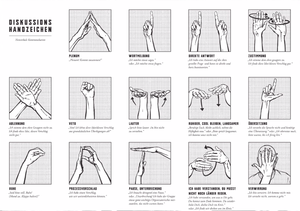
In her talk "The Workshop as an Emancipatory Mediation Method of Resistant Practices" political activist Hanna Poddig referred to the
discussion scores that are also common in Consensus Decision-making practices
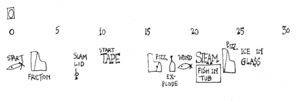
"A section of Water Walk," score by John Cage
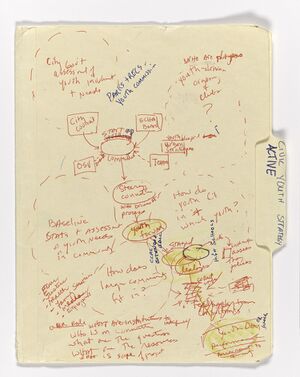
Notes by Suzanne Lacy on the ongoing civic engagement in Oakland and the Oakland Youth Policy Initiative. Image courtesy of Suzanne Lacy.
Workshop Histories and Practices
In conversation with Heike Roms
Anja Groten: In May 2021 I participated in an online conference titled “The Workshop as Artistic-Political Format,” organized by Institute for Cultural Inquiry in Berlin.[1] The conference drew together practitioners from various fields of interests, including choreographers, dancers, theater makers, artists, scholars, musicians, and activists who reflected on “workshop” as a format, site, and phenomenon from their own perspectives. Heike, you gave the presentation "The Changing Fate of the Workshop and the Emergence of Live Art,” which particularly resonated with me.
Heike Roms: I came to the topic of workshops because in my work I look at the emergence of performance art in the sixties and seventies. I became interested in particular in the emergence of performance art within art educational contexts, in a conceptualization of a pedagogy of performance. I've read your chapter on “Workshop Production,”[2] which I really enjoyed. Some of the research you've done is helpful to me because I too have found that there's actually very little written about the workshop as a practice. That is, people have written about specific workshops so you can find material on workshops given by a particular artist. But there is little reflection on the workshop as a format, as a genre, as a site, as whatever we might call it. That surprised me, given that it's sort of ubiquitous in practice. There are books on performance laboratories, for example, and there is a connected history between the workshop and labs, the studio space, and rehearsals as a format. But there is very little on the workshop, certainly within performance studies or art history discourse, so I became intrigued by this ubiquitous form that remains largely unexamined. It's great that through the work of Kai van Eikels and the 2021 conference he co-organized there's a new kind of attention being paid to it, through your work as well. But there is not enough available about the history of the workshop to help us understand at what point this flip occurred from considering the workshop as an actual physical site to approaching the workshop as an event format. You write about this as well. The two meanings, of course, continued to exist in parallel, particularly in the context of art schools. But at what point did the workshop become an event, a time-based learning experience, as well as a site of making—a Werkstatt? I don't know how and when that occurred. My suspicion is that it was sometime around the fifties and sixties.
AG: There is the The Journal of Educational Sociology that was published in 1951 and refers to the first organized professional education activity under the name of a workshop. It took place at Ohio State University in 1936.[3] I remember you were talking about the relation between the occurrence of workshops and the emergence of a certain resistance toward the steady structures of art schools in the fifties and sixties in the UK—a resistance to legitimized knowledge practices and skills. Art students wanted to rid themselves of a certain authority of disciplines or disciplined learning and instead wanted to take things into their own hands.
HR: In the specific history I looked at, which is that of Cardiff College of Art, I found that there is a confluence between the workshop and two emancipatory movements. First was the move toward the workshop as a learning format through the impetus of the Bauhaus, which in the 1960s developed a huge impact on art schools across the UK. Traditionally people weren’t really talking about workshops as sites of making in the context of art schools; the workshop was the place of the plumber or the blacksmith, while artists worked in ateliers or studios. I think that the idea of the workshop as a place of making was introduced to the art school through the Bauhaus philosophy, which was a vehicle for the emancipation of art education. All of a sudden art was being approached in the same way as other practices of making were being approached. No longer did we have the sculpture atelier or the drawing room. Now there were ceramics workshops, metal workshops, printmaking workshops but also painting workshops and sculpture workshops (or ‘2D’ and ‘3D’ workshops as they were often called at the time). This move introduced a different kind of art making.
This change that occurred in art schools in the UK in the sixties through a new approach to art education known as ‘Basic Design’ was very much driven by the reception of the Bauhaus approach and in particular Joseph Itten’s Vorkurs (preliminary course). Workshop production was seen as a new, more emancipatory form of art making. It came out of the experiences of the Second World War and the desire to give art students a different sort of experience—one that connected them to the contemporary world rather than traditional skills training and that aimed to overcome the distinction between art, craft and design.
The second shift is where performance comes in in the 1960s. Teachers and students saying: We don't want all of that material making in the workshop. We want to make something that's ephemeral and that's collective and that's participatory. We don't want to be hammering away all day in the workshop. Instead we do this other thing where we get together and we make something that’s not actually about producing any objects, and we'll call that a workshop as well. That's the event-based rather than space-based concept of the workshop.
In dance, people were already talking about workshops as events in the fifties. I don't know when the shift occurred from the workshop as a site toward the more ephemeral understanding of the workshop as event, how that happened, but it's interesting because what motivated the artists in the sixties that I have been looking at—and they explicitly say so in their notes—was that this move toward the ephemeral was about searching for more equitable relationships that do away with the teacher-student division. That division had been further cemented by the remains of the Bauhaus philosophy and its celebration of mastery. I think that was one of the key shifts toward this more ephemeral meaning of the workshop. It was no longer about a master passing on knowledge to their students. It became about collective making. And everybody took collective charge and responsibility for that making. The educators on whom I've done research actually say that they wanted to get away from producing objects toward collective action. But, as you say, the workshop can very easily be co-opted like so much of the sixties was. Was that the last hurrah of collectivism? Or was it actually what lay the groundwork for the entry of neoliberalism into education as we now know it?
AG: I myself am wondering whether organizing workshops can generally be considered an emancipatory practice at all? Perhaps there cannot or should not be a general answer to this question. At the school where I work as an educator, some argue the educational system builds upon rather precarious labor conditions, where everyone works as a self-employed freelancer. Simultaneously, more and more workshops are being organized, which at times can clutter the education. Students are supposed to self-initiate and self-organize as well. They often resort to organizing workshops for each other. In my view, such conditions sometimes also show the limits of what can be accomplished with workshops. I think it's important to have more discussions about the workshop as a format and its implications for the learning economy. How to speak about and practice workshops in a way that still allows us to do the things we want to do, whilst also paying critical attention to the undesirable conditions it is intermingled with.
How was it for you? Did the invitation to the conference lead you to take a deeper look at the phenomenon of the workshop? Or were you already busy with it?
HR: Yes, it would be fair to say it led to a deeper engagement with the notion of the workshop. I had been working on this material before and I've written about it too. But I had never really paid attention to the frequency of the word ‘workshop’ in the material I had researched until the invitation came to speak at the conference. It was then that I realized that the workshop is a really productive format to be talking about.
I wrote a paper on this before in which I talked about the idea that artists and performance educators in the sixties and seventies in the UK were creating events as a kind of parallel institution. These events aimed to serve the function of an art school without replicating its hierarchical structures. This was the case in Cardiff, but also in other places in the UK such as Leeds College of Art. I was grateful that I was invited to think more about this by the conference. I looked at my examples, and it is specifically “the workshop as event” that emerged as a kind of parallel institution at the time. It wasn't really the performances these teachers and students went on to make together, but the workshop as a learning format that I think they clustered all their ideas around.
AG: I stumbled upon the conference last minute and wasn't aware of this whole community of performance artists and live arts who consider the workshop as an artistic medium. It's also interesting that the workshop, because of its ambiguity, manages to converge all these different worlds and unveil commonalities between them. For instance a policeman[4] speaking about their conflict resolution workshops, and the activist who learns about tying themselves to a tree and how to negotiate with the police while doing so [5]. Both speaking about the same sort of thing at the same conference from an entirely different vantage point.
You emphasized that a lot of the artists you researched were also educators. It was great to hear that engaged with in such an explicit manner. I don’t often hear about how the practices of artists and designers continue to evolve within particular educational environments, after they have completed their studies too. I find that many great artists and designers are also teachers and I personally don’t draw a harsh distinction between being an educator and being a designer. The practices go hand in hand. But I found that there are not many records of the teaching practices of artists and designers. Another thing from your talk that really stayed with me was your re-enactment of a workshop. You showed some pictures and I found them so interesting and also funny. In your re-enactment, you imagined through physical exercises what the workshop might have looked like. You referred to one specific artist educator, whose name I don’t recall.
HR: His name is John Gingell, and he is not particularly well known. I never met him in person, as he had already passed away by the time I became interested in his work. He had a sculptural practice, and a few of his public artworks are still on view in Cardiff, and some of this work has been exhibited in London. But really he was an educator. That was his main practice. He formed and shaped generations of art students. He was not the type of person to write manifestos, or write a lot in general, but I've been very fortunate because his family has allowed me to look at all of his materials, which are now kept in the attic of one of his daughters. He didn't leave a written philosophy of teaching or anything like that, just really random notes or little statements that he put together for the art school in order to justify what he was doing, or presentation outlines and things like that.
I didn't re-enact any of his workshops because they were very sketchily documented. He was not somebody who kept a particularly developed documentation or scoring practice. If I think about my own teaching, I don't either. When I enter a classroom, I often just jot down some notes on the exercises I want to do. They're just little prompts, which aren’t accompanied with much explanation. In years to come, if somebody were to look at my teaching notes, they too wouldn’t be able to make much sense of what I was doing in the classroom. I don't think that's unusual. Anyway, I have contact with one of Gingell’s students from the late 1960s, the artist John Danvers, who also taught at the art school for a number of years in the seventies. He was very influenced by John Cage, so his own artistic practice was already very score-based. When he became a teacher his teaching practice was very well documented. He documented the exercises alongside photos of the students doing the exercises. He has quite substantive documentation on the courses he taught at Cardiff.
Interestingly, one of his regular classes in the early 1970s for Cardiff College of Art was a workshop about the use of sounds and words, which was unusual for an art school context. I invited him in 2013 to re-enact the workshop as part of the Experimentica Festival in Cardiff. Anybody could attend, but it was mainly my friends who came [laughs]. A lot of the people who attended were theatre people, and their feedback was that Danvers’ exercises and the approach that he took spoke very much of a visual arts kind of sensibility. Even though he was working with words and sounds—which have a theatrical dimension—their purpose was much less about what theatre workshops tend to focus on, such as the interpretation of words or meaning-making. Instead, Danvers’ workshop was much more about the visual qualities of words and sounds. There was much more concern about spatiality and the sculptural qualities of words. Danvers approached his teaching practice very much as a conceptual practice, and so it was fairly easy to reconstruct what he did in his workshops. I've always been intrigued by this hidden history of pedagogy within the emergence of experimental art. We read a lot about John Cage and his teaching at the New School in New York, but I often think, what did they actually do in his classes? There are some accounts of his students about the improvisations they did with Cage, but very little. I'm intrigued to learn more. Beuys too was a teacher as well as an artist, who considered teaching his ‘greatest work of art’ and a key part of his practice. There are others, too, like Suzanne Lacy and Allan Kaprow, who both taught at CalArts. In fact, a lot of the canonical performance artists were also often teachers. Some of them, Kaprow, for instance, also wrote about education.
AG: I was also wondering about how you document workshops. As you said yourself, even though you come up with the initial class or workshop, it is to a large extent shaped in the actual encounter with the people, materials, and space itself. It is obviously not so interesting nor meaningful to just take pictures of people having a great time. So what are ways of documenting that afford a continuation of whatever is happening in these short workshop encounters, and which allow for retrospective discussion and reflection of these workshop practices? The way I document workshops is usually very messy. Our workshop archive is scattered in different places, online and as well as offline.
I was wondering, sometimes we compare workshop scripts with protocols and orchestrate physical re-enactments of what a computer would do, translating something that happens in your machine into a physical space. I am not very familiar with scoring practice but what I do know makes me think of protocols or algorithms. It's not a recording or a replica of a situation, but it sort of anticipates it, sets conditions. I wonder if it could help us think about documentation as something that is not only about looking back, but in fact geared toward continuation and activation in the future.
HR: From the sixties onwards, through Happenings and Fluxus, practices of scoring actions have become a common device in visual arts. And in performance art and dance, very extensive scoring practices have emerged. The indeterminacy of the score or instruction is partly what interests artists. You give somebody a score, and it could be interpreted in a hundred different ways. That's why it is interesting to consider where the artwork is located in these practices. Is the score the artwork? Is it the realization of the score the artwork? A Fluxus score, for instance, wouldn't even tell you how many people have to carry it out. Such a score could be about the very indeterminacy of an action.
Traditionally, we think of the author of the score as the author of the work, such as in musical compositions, for example. But more recently, we are seeing much more experimentation with scoring practices, and with the relationship between the score and the event or action that it might anticipate or generate. A few years ago Hans Ulrich Obrist did a large-scale curatorial project called “do it,”[6] which invited artists who don't normally have a scoring practice to write their own scores or instructions. People were invited to enact these score and then upload documentation of the enactment online so that you could see the score, as well as a multitude of different kinds of documentation of the different kinds of outcomes produced by their enactments.
AG: I am trying to think through the question of how to publish something like a workshop or a workshop script. In my view it can be an interesting graphic design object because it's very unresolved, very spontaneous, it's actually not a precious object, and it’s never up to date. These criteria are significant for it to function. But how do we publish something like that in a meaningful way? For instance, pictures of workshop situations can help to contextualize something like a score or workshop script. You cannot just give the score to someone and expect them to know what they have to do and how to be excited about it. You need that activation moment and know-how too. But including snapshots of people doing things is not necessarily interesting to print in a book.
HR: It brings us back to the fact that there are different kinds of workshops and different kinds of scores. There are those that are meant to be indeterminate and generate lots of different kinds of responses. Every response is justified and equally valid. Sometimes visual documentation can therefore be too prescriptive. If you see a score and somebody enacting it, you might think, well, that's the only way to do it. It takes a little bit of your agency away. Unless you do it like the DIY “Do It” project, where you provide the documentation of multiple enactments so you encourage people to try their own response by showing them five different versions. But then there are also scores where which are much more prescriptive, and people want them to be enacted in a particular kind of way, particularly often in pedagogical contexts. Do you want the exercise to land in a particular way, because you want the students to have a particular kind of learning experience? There are different scoring practices, different ways to shape an instruction, and similarly there are different kinds of documentation practices that might be suitable. Yet, I would say that it's the “doing,” the activation and interpretation of a score, that's interesting. It's all about the finding process and the kind of rationalization and reflexivity that you go through in this process that I find exciting. It’s often just as interesting to look at how a person struggled through finding a response to a a score or instruction than the response itself.
AG: You also teach workshops for children. What are they about?
HR: I have been involved in some performance work with children through my collaboration with the artist Sibylle Peters, who runs a theater for children in Hamburg, the FundusTheater/ Forschungstheater. Sibylle calls it a “theatre of research”.[7] The philosophy is that research is something that brings artists, children and scholars together, as it's something that artists do, it's something that children do, and it's something that scholars do. She devises projects around different themes which are of particular interest to the children she researches with and are often driven by their desires, such as ‘I want to be rich’, which led to an examination of the nature of money and the founding of a children’s bank with its own micro-currency in Hamburg. I did several projects with Sabine, where I was invited for my knowledge of performance art history. The last project we did was, Kaputt – The Academy of Destruction at Tate Modern in 2017. Destruction is a really big subject for children, because they're often told they are destructive or have destructive behavior.
We worked with children who were diagnosed with behavioral issues, who showed what was deemed destructive behavior in class, or who were really interested in watching cartoons where things get destroyed. Kids see and hear about destruction all the time, for example the destruction of the environment. When we were doing the project in London, seventy-two people had recently died in the Grenfell Tower fire as a result of negligence.[8] It was close to where the children we worked with came from, and it was very present in their minds. But there's no real outlet for children to explore their fears about destruction, but also their interests and pleasures in destructiveness and their destructive fantasies. We worked with the children on the notion of destruction for a week. We were all considered equal experts on the subject, and we all shared our expertise. The kids gave talks, for example about destruction in comics and animation. I gave a talk on destruction and art. Sybille has done lots of these kinds of projects, which I occasionally get invited to participate in and work on issues that overlap with the histories of art. Inspired by our work together, I have recently begun to research the participation of children in the history of avant-garde art, especially in the performance practices of Happenings and Fluxus.
What is important to Sibylle as well is this idea of the workshop as a space for equitable relationships. She takes seriously what the kids bring to the discussion. And it's always about rethinking and reshaping the adult-kid relationships. We will be working together again in September 2022 on the occasion of the opening of a new building for the Fundus Theater in Hamburg. For that event I am currently working on some research that looks at child activism in the sixties, especially the involvement of children in the American Civil Rights movement, and how that intersected with children's participation in experimental art projects at the time. How children were trained for their participation in protest or art with the help of workshops will be a major aspect of this research too.
Heike Roms is Professor in Theater and Performance at the University of Exeter, UK. Her research is interested in the history and historiography of performance art in the 1960s and 1970s, especially in the context of the UK. She is currently working on a project on performance art’s pedagogical histories and the development of performance in the context of British art schools.
- ↑ “The Workshop: Investigations Into an Artistic-Political Format,” ICI Berlin, March 26-28, 2021, https://www.ici-berlin.org/events/the-workshop/.
- ↑ Anja Groten, “Workshop Production,” Figuring Things Out Together. On the Relationship Between Design and Collective Practice (PhD Diss., Leiden University, 2022).
- ↑ The Journal of Educational Sociology, Vol. 24, No. 5 (Jan1951): 249-250, https://www.jstor.org/stable/2263638.
- ↑ Sebastian Voigt (Polizei Berlin), "The Training of the Berlin Police Force in the Workshop"
- ↑ Hanna Poddig, "The Workshop as an Emancipatory Mediation Method of Resistant Practices"
- ↑ “do it (2013-) curated by Hans Ulrich Obrist,” Independent Curators International, https://curatorsintl.org/exhibitions/18072-do-it-2013.
- ↑ Sibylle Peters, performing research: How to conduct research projects with kids and adults using Live Art strategies, (London: Live Art Development Agency, 2017), https://www.thisisliveart.co.uk/wp-content/uploads/uploads/documents/SYBILLE_TOOLKIT_WEB.pdf.
- ↑ “Grenfell Tower fire,” Wikipedia, last modified October 10, 2022, https://en.wikipedia.org/wiki/Grenfell_Tower_fire.
